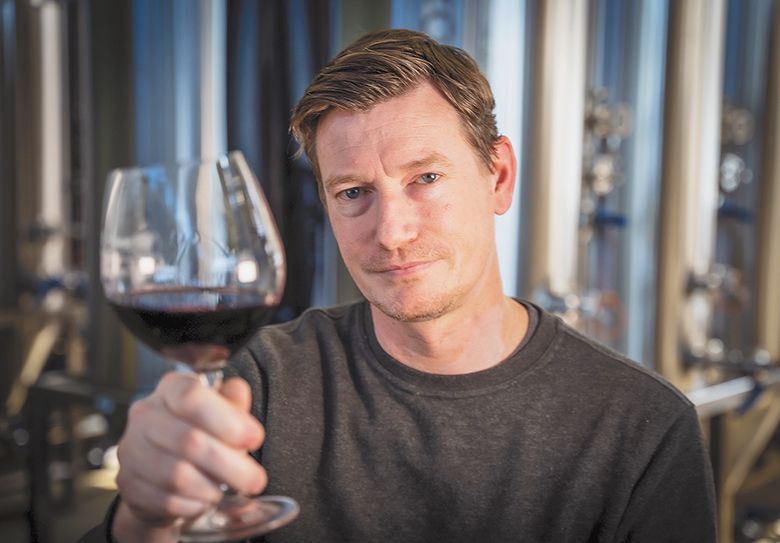The Doctor Is In
Dr. James Osborne leads Oregon Wine Research institute

By Brooke Strickland
James Osborne obviously loves discussing complexities in wine. He was recently named director of the Oregon Wine Research Institute, or OWRI, at Oregon State University’s College of Agricultural Sciences. The microbiologist’s knowledge extends far beyond the basic science of wine and winemaking. It dives deep into the glass, providing a glimpse into the tiny organisms that convey each wine’s unique story.
Originally from New Zealand– a country of stunning landscapes, natural geography and world-class wines– Osborne grew up on a dairy farm. He gained an innate appreciation for nature while learning the inner workings of farm life. After high school, Osborne studied agricultural sciences, including microbiology. Discussing the production of beer, wine and cheese opened a new world. Osborne decided on a career as a microbiologist, earning undergraduate and graduate degrees in microbiology from Massey University in New Zealand. In 2005, he completed his Ph.D. in food science at Washington State University, Pullman.
As Osborne learned more about wine from the scientific, academic perspective, his interest grew. Clearly, this was becoming a lifelong passion. After earning his Ph.D., Osborne returned to New Zealand and accepted a role teaching and managing a research winery at the University of Auckland’s nascent wine science program.
“People come to the wine industry for all different reasons– and my story is unique,” Osborne explained.
Following his university role, he joined the lab at Delegat Oyster Bay, a large New Zealand-based winery making a million-cases annually. Osborne worked harvest and learned how to run a winery, including the production side. This experience provided the knowledge necessary for a wine career.
In 2006, Osborne returned to the States and accepted a position at Oregon State University, or OSU. He continued studying the process of what happens inside the wine glass, examining yeast and fermentation, learning how to enhance winemaking techniques. Osborne also studied organisms that lead to spoilage and how best to control or prevent them.
Osborne stepped into his current position last November. His primary duties include coordinating the efforts of OWRI researchers and staff in collaborative, multi-disciplinary exploration. Another aspect of his new job involves connections supporting winemakers and wineries across Oregon. Osborne works alongside integrational wine research scientists, associate faculty, and others. He also helps supervise students in their research areas. Osborne remains focused on creating partnerships and collaborations with those within the industry.
“I’m still kind of getting my feet under me,” he explained. “I’m hiring staff which will change how we handle industry outreach and events. There are a lot of new things coming along. We are really focused on increasing and improving our visibility, nationally and internationally, within the scientific community.”
Regarding various research projects with his team of 10 scientists, Osborne says most of the funding comes from industry or industry-related sources. They also develop research proposals for funding. Some projects might be smaller since they need to develop control strategies and methods to monitor progress. Longer-term studies include adapting to climate change and its impact on Oregon grapes and wine.
“Projects are generally two to three years,” he said. “Federal funding agencies have longer cycles– sometimes five years or longer. We spend significant time grant writing, and try to be responsive to industry needs. OSU worked closely with early industry pioneers in the development of new clones and how best to grow grapes. That history of research and development began in the 1960s and 1970s. Today, there is a lot of refinement and understanding of what makes Oregon wine unique– what makes it so high quality, what microbiological things are happening and how we can utilize that. The Oregon wine industry survives on quality– it’s not a large industry. How can we improve quality and drive that forward?”
Osborne explains how technology figures significantly in his research. Looking ahead in this new position, he and his team search for methods to increase efficiency.
He said, “There has been a shift toward improving efficiencies, including automation and even artificial intelligence. There will always be new technologies enabling us to do research in new areas– you’ve got to be very adaptive.”
What continues to inspire him is simple, Osborne says: the people.
“I’m inspired by the industry,” he shared. “I work with scientists in a wide variety of fields, as well as graduate and undergraduate students that I enjoy as well.”
Osborne anticipates building relationships with talented, diverse people in our wine industry. The Oregon State University Research and Teaching Winery is also undergoing a total renovation as part of a larger aim of renovating Withycombe Hall. This will increase the winery from 900 square feet to over 2,500, allowing space for additional teaching opportunities and research projects.
“To be able to teach and conduct research…I find it all fascinating,” Osborne said. “Every day is different, and it’s hard to be bored.”
A lifelong resident of the Pacific Northwest, Brooke Strickland is a full-time freelance writer that specializes in writing blogs, website content, and business news for companies & publications around the country. She is also the co-author of Hooked on Games, a book about technology and video game addiction. When she's not writing, you can find her on her porch swing reading a historical fiction novel with a glass of rosé or hanging out with her husband and 2 kids.










